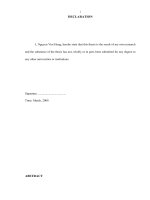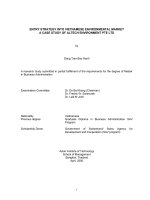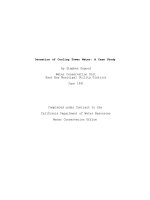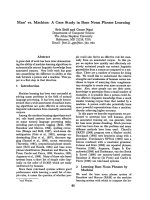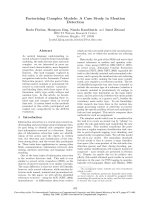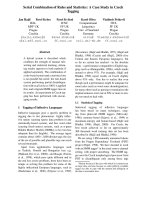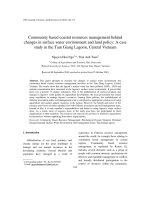Labor supply of vietnamese brides households a case study in vinh long
Bạn đang xem bản rút gọn của tài liệu. Xem và tải ngay bản đầy đủ của tài liệu tại đây (1.27 MB, 80 trang )
MINISTRY OF EDUCATION AND TRAINING
UNIVERSITY OF ECONOMICS HO CHI MINH CITY
--- ---
NGUYEN THI NHUNG
LABOR SUPPLY OF VIETNAMESE BRIDES’
HOUSEHOLDS – A CASE STUDY IN VINH LONG
MASTER OF PUBLIC POLICY THESIS
HO CHI MINH CITY - 2013
MINISTRY OF EDUCATION AND TRAINING
UNIVERSITY OF ECONOMICS HO CHI MINH CITY
FULBRIGHT ECONOMICS TEACHING PROGRAM
--- ---
NGUYEN THI NHUNG
LABOR SUPPLY OF VIETNAMESE BRIDES’
HOUSEHOLDS – A CASE STUDY IN VINH LONG
Public Policy Major
Code: 60340402
MASTER OF PUBLIC POLICY THESIS
SUPERVISOR
DR. JONATHAN R. PINCUS
HO CHI MINH CITY - 2013
-i-
CERTIFICATION
I certify that I wrote this thesis myself.
I certify that the substance of the thesis has not already been submitted for any degree and
is not being currently submitted for any other degree.
I certify that any help and all sources have been acknowledged in this thesis with my best
of knowledge.
The study does not necessary reflect the views of the Ho Chi Minh City Economics
University or Fulbright Economics Teaching Program.
Author
Nguyen Thi Nhung
-ii-
To my family, friends, FETP and my supervisor Dr. Jonathan R. Pincus
For the foundation of love
And the structure of support
-iii-
TABLE OF CONTENS
CERTIFICATION ................................................................................................................ i
TABLE OF CONTENS ...................................................................................................... iii
ABSTRACT ......................................................................................................................... vi
ABBREVIATIONS ............................................................................................................ vii
LIST OF TABLES ............................................................................................................ viii
LIST OF FIGURES ............................................................................................................ ix
LIST OF BOXES ................................................................................................................. x
CHAPTER 1 INTRODUCTION ........................................................................................ 1
1.1. Problem statement ....................................................................................................... 1
1.2. Research statement of the study .................................................................................. 2
1.3. Study objectives .......................................................................................................... 2
1.4. Data and methodology ................................................................................................ 2
1.4.1. Data....................................................................................................................... 2
1.4.2. Methodology......................................................................................................... 3
1.5. The structure of the study............................................................................................ 3
CHAPTER 2 LITERATURE REVIEW ............................................................................ 4
2.1. Relevant concepts........................................................................................................ 4
2.2. Theoretical background ............................................................................................... 5
2.2.1. The hours of work decision .................................................................................. 6
2.2.2. The hours of work changes when non-labor income changes .............................. 6
2.3. Empirical studies of labor supply ................................................................................ 8
2.4. Conclusion................................................................................................................... 8
CHAPTER 3 RESEARCH METHOD .............................................................................. 9
3.1. Research method ......................................................................................................... 9
3.2. The structure of the survey.......................................................................................... 9
-iv-
3.3. Survey sample size and sampling method ................................................................ 10
3.4. Data collection instrument ........................................................................................ 11
3.5. Limitations of the survey .......................................................................................... 11
CHAPTER
4
LABOR
SUPPLY
OF
TRANSNATIONAL
WOMEN’S
HOUSEHOLDS IN VINH LONG ................................................................................... 13
4.1. Basic information ...................................................................................................... 13
4.2. Transnational marriages affect the livelihood strategies of the relevant households 14
4.2.1. Property .............................................................................................................. 14
4.2.2. Main income ....................................................................................................... 18
4.2.3. The support of married women .......................................................................... 19
4.2.4. Changes in hours of work, leisure activities and incomes .................................. 25
4.3. Changes in labor supply of male relatives of transnational brides............................ 28
4.3.1. Job types, occupations and hours of work .......................................................... 28
4.3.2. Working motivation............................................................................................ 31
4.4. Unemployment and dependency ratio ....................................................................... 36
4.4.1. Dependency ratio ................................................................................................ 36
4.4.2. Unemployment ................................................................................................... 38
4.5. The support from male relatives to transnational brides ........................................... 42
4.6. Conclusion................................................................................................................. 43
CHAPTER 5 RECOMMENDATION ............................................................................. 45
5.1. Households should develop their economics activities and make use of remittances
.......................................................................................................................................... 45
5.2. Education should be available to the people to find job opportunities ..................... 45
5.3. Migrant’s households should invest and help other households ............................... 46
CHAPTER 6 CONCLUSION ........................................................................................... 47
6.1. Conclusion................................................................................................................. 47
-v-
6.2. Limitations of the study ............................................................................................ 47
REFERENCES................................................................................................................... 49
Vietnamese ....................................................................................................................... 49
English.............................................................................................................................. 49
APPENDIXES .................................................................................................................... 50
-vi-
ABSTRACT
This study examines the labor supply of households in Vinh Long Province in which at
least one female member has left the country after marrying a foreign national. It compares
characteristics of 168 married women’s households. In particular, the study focuses on
households in which women marry foreigners voluntarily. Transnational marriage has been
common in many districts of Vinh Long for a long time. Women who marry foreigners
contribute to the well-being of their households of origin. Households in which
transnational women have lived abroad have more children and elderly than non-migrant’s
households. In addition, a large number of laborers in these households do not earn money
and rely on remittances. Households with migrants (transnational women) have more
opportunities for sustainable livelihoods. However, they have not made use of the support
that the migrant women provide. They lack effective strategies to increase their labor
income as well as protect their transnational women. Men are more likely to move out the
labor market. Accordingly, the study’s policy recommendations pertain to creating job
opportunities for women and stimulating labor supply on the part of men to increase
household incomes.
Key words: Labor supply, households, males, transnational marriage, transnational
women.
-vii-
ABBREVIATIONS
HCMC
:
Ho Chi Minh City
NGO
:
Non Governmental Organization
VND
:
Vietnamese Dongs
USD
:
United State Dollars
-viii-
LIST OF TABLES
Table 4.1 The difference of house areas ........................................................................... 14
Table 4.2 The difference of garden and paddy areas of households ............................. 17
Table 4.3 Males’ average hours of work .......................................................................... 30
Table 4.4 Males’ education levels ..................................................................................... 31
Table 4.5 The hours that men are willing to work more ................................................ 34
Table 4.6 The reasons that men are unwilling to do a second job ................................. 35
Table 4.7 Dependency ratios of households ..................................................................... 37
Table 4.8 Difference of household sizes ........................................................................... 37
Table 4.9 People who move out of labor force in two groups ........................................ 39
-ix-
LIST OF FIGURES
Figure 2.1 The budget line .................................................................................................. 5
Figure 2.2 An interior solution to the labor – leisure decision ........................................ 6
Figure 2.3 The effect of a change in non labor income on hours of work ...................... 7
Figure 4.1 The number of economics activities of households ....................................... 18
Figure 4.2 The support of married women for their relatives ....................................... 19
Figure 4.3 Changes in hours of work, leisure time and incomes ................................... 25
Figure 4.4 Job titles of male relatives ............................................................................... 28
Figure 4.5 Future plans of households ............................................................................. 32
Figure 4.6 The support of males to their married women ............................................. 42
-x-
LIST OF BOXES
Box 3.1 Work in Nguyen Van Thanh Commune and My Hoa Commune ................... 10
Box 4.1 Women help their mother by transnational marriages .................................... 20
Box 4.2 “We thank our daughters” .................................................................................. 21
Box 4.3 A man who has lost his farm land....................................................................... 23
Box 4.4 A household that has lost one laborer ................................................................ 23
Box 4.5 Future plans with Nguyen Van Thanh’s new traditional market ................... 33
Box 4.6 A hard worker ...................................................................................................... 39
Box 4.7 A young man who has to take care of his parents ............................................. 40
Box 4.8 The alcoholics and a temporary unemployed .................................................... 41
-1-
CHAPTER 1
INTRODUCTION
1.1. Problem statement
Transnational marriage has been a common phenomenon in the Mekong Delta for over two
decades. About 300,000 Vietnamese women have married foreigners in the entire country
between the years 1987 and 2010. Among them, 35,000 women have gone to Korea and
85,000 to Taiwan or China. These numbers have continued to increase. Many towns in the
Mekong Delta have “Taiwanese villages” or “Korean villages” because the thousands of
foreign sons-in-laws married to local women. Vinh Long, Tay Ninh, Can Tho, and Tien
Giang provinces have recorded the largest number of transnational marriages.
The Mekong Delta still has some of the poorest provinces in Vietnam. The economy of
Vinh Long depends heavily on agriculture. People have fewer job opportunities in the
service and industrial sectors. Laborers usually work in neighboring cities. With low
education levels, more and more women have married foreigners to escape from poverty.
From 1987 to 2012, the Vinh Long Department of Justice issued more than 10,000
marriage certificates for foreign grooms and Vietnamese brides. Almost all of these young
girls are poor and unskilled. Some of them get married to help their families. Others marry
to compete with neighbors who have lived abroad. A large number of women get married
to the disabled men and some are treated badly. It is difficult for them to live abroad
because they lack knowledge, skills and language capabilities. The transnational women’s
relatives hope that migrant women can earn money abroad and send some back. Without
adequate preparation, women cannot find good jobs. However, their male relatives cannot
support them before and after they get married. Their remittances lead men to increase
leisure time, and not invest in education or economic activities. Based on this situation, the
study aims to analyze the labor supply of transnational bride’s households in Vinh Long, a
typical town with transnational marriages.
-2-
1.2. Research statement of the study
This study attempts to answer these research questions:
How does marriage to foreigners affect the livelihood strategies of the households of
women in transnational marriages?
How does the labor supply of male relatives of transnational brides change?
What policies could the government adopt to stimulate labor supply on the part of the male
relatives of transnational brides?
1.3. Study objectives
This study examines the relationship between labor income and non-labor income of
transnational brides’ households. Remittances constitute significant non-labor income that
may have an effect on the labor supply of other household members. This paper also
explores the reasons for poverty among households of transnational brides and considers
policies to increase the supply of labor from these households to increase labor income.
1.4. Data and methodology
1.4.1. Data
1.4.1.1. Original data
The survey was conducted in fifteen hamlets in four districts of Vinh Long Province. The
districts with most marriage migrants are Binh Minh, Binh Tan, Tam Binh and Tra On.
They are identified based on reports of the Justice Department. When transnational couples
register legal marriage certificates, they come to this department first. The author chose
Vung Liem, instead of Binh Minh to make sure that these areas have some differences
because Binh Tan was once a small part of Binh Minh District. The survey includes 168
households of migrants and non-migrants.
First, the People’s Committees gave permission for the survey and the commune leaders
supplied the household lists. The second group consisted of non-migrant households in the
same villages selected randomly.
-3-
1.4.1.2. Secondary data
The People’s Committee contributed some reports such as Vinh Long’s socio – economic
development strategy (2011 – 2020), human resource development planning (2010 –
2020) and other figures.
The Department of Labor, War Invalids and Social Affairs provided annual reports of the
1965 national program for skills training for rural laborers.
The Women’s Union provided reports of “The Advancement of Women” program and
information on programs supporting women.
Additional information was obtained from non-government organizations and scholars.
1.4.2. Methodology
This study uses qualitative research methods to analyze the labor supply of men in
households with and without transnational brides. With the theory of labor – leisure choice,
this study proves that men and households of transnational women are reducing their hours
of work. Also, men are unwilling to work more. The study uses t-tests to compare means
of important household indicators such as land area, hours of work and education levels of
men. The t-tests assume two samples of unequal variances. In this test, the null hypothesis
H0 is µ 1 = µ 2 in which µ 1 and µ 2 are the means. The alternative hypothesis Ha is µ 1
µ 2,
which would mean that the two means are significantly different from each other. This
study not only gives a formal framework but also adds some descriptive information that
reveals some special cases of households to support the main arguments in the text.
1.5. The structure of the study
The study consists of five chapters. Chapter 1 describes the research problem. Chapter 2
reviews the relevant literature in order to provide an analytical framework for studying the
relationship between remittances and labor supply. The next Chapter describes the research
methods and relevant details of the survey. Chapter 4 presents the results of the survey, and
the final chapter concludes, gives some policy recommendations and discusses the
limitations of the paper.
-4-
CHAPTER 2
LITERATURE REVIEW
2.1. Relevant concepts
The household is a group of people living together in shared accommodation and with
common domestic expenses. Households usually but not always contain people who are
related or cohabitating. Whereas the individual is the recipient of income, the household is
the unit through which consumption expenditure is decided.
Hours of work are the number of hours per day or per week that a worker is contracted to
perform labor. This may be decided by negotiation, individually or through trade unions, or
limited by law. Work in excess of these hours is overtime. Workers who do not have
employment for at least forty hours per week are considered part time or irregular
employees. Most casual labor jobs do not guarantee full employment.
Income is the amount an individual can spend in a given period while leaving his or her
capital unchanged. For an individual with neither assets nor debts, personal income can be
defined as receipts from wages, or earned income, plus receipts from transfers, such as
pensions. Net income is income after payment of direct taxes. This study mentions “net
income”.
Unearned income is personal income derived from property ownership rather than work. It
thus consists of rent, dividends and interest.1
An adult who is “not working” is an individual of working age (fifteen years of age) but
not in school or earning income. This person can be a head of household or member and
lives at the same house with their relatives or other household members. Other household
members give them money and food. People may not work for variety of reasons, some of
which are involuntary (disability) and some voluntary.
1
Oxford Dictionary of Economics (2003)
-5-
Casual workers are persons who may earn daily income. They can work as manual workers
in agricultural or other jobs and do not have permanent employers. They may be seasonally
unemployed after finishing their jobs.
Transnational women (Vietnamese brides) are women who have married men resident in
other countries voluntarily. She and her husband have legally registered their marriage at
the Department of Justice or the embassy of the husband’s home country. Their marriage is
regulated by the Law of Marriage and Family in Vietnam. Trafficked women or women
forced to migrate, marry or work against their will, are not discussed in this study.
2.2. Theoretical background
This study is based on the theory of labor supply, called the neoclassical model of labor –
leisure choice. A person has limited time per day to work and rest. He or she can work all
of the time or give all of his or her hours to leisure activities. When working, he or she can
purchase consumption goods. Each hour of leisure given up allows him or her to consume
more goods. On the other hand, he or she chooses the level of consumption and leisure
activities to maximize his or her utility.
Figure 2.1 The budget line
Source: Borjas, Labor economics (2003, p. 23)
-6-
2.2.1. The hours of work decision
An example will help clarify this statement. The worker has a budget line EF as shown in
Figure 2.1. There are many utility points on this line. But he has the utility index U* that
gives the highest possible level of the utility (Figure 2.2). The tangent of U* and EF is P,
at which the worker works 40 hours and rests 70 hours per week. It assumes that this
worker sleeps eight hours per day.
With 40 hours of work, he can consume 500 thousand Vietnam dongs (VND) worth of
goods weekly. Point A and Y do not maximize his utility because of the limitation of the
budget line.
2.2.2. The hours of work changes when non-labor income changes
If this person has non labor income such as a pension, unearned income or remittances, he
will change his or her hours of work.
Figure 2.2 An interior solution to the labor – leisure decision
Source: Borjas, Labor economics (2005, p.33)
-7-
One important assumption is that the worker receives non labor income of 100 thousand
VND per week. Now, if he increases non-labor income to 200 thousand VND weekly, the
new budget line is given by F1E1. When the worker’s wage rate is held constant, the slope
of the budget line originating at point E1 and point E0 are the same.
With the increase in non-labor income, the worker now jumps to a higher indifference
curve at point P1. The expansion of the opportunity set increases both expenditures on
consumption goods and the number of leisure hours, increasing the length of the workweek
to fifty hours. This is the income effect, the impact of the change in non-labor income
(holding wages constant) on the number of working hours.
Figure 2.3 The effect of a change in non labor income on hours of work
When considering leisure a “normal” good or an “inferior” good, this worker probably
reaches the conclusion that leisure activities are a normal good. Then, when this worker is
wealthier, he will surely demand more leisure. The income effect, therefore, implies that
an increase in non labor income, holding the wage rate constant, reduces hours of work.
-8-
2.3. Empirical studies of labor supply
Many scholars have conducted research on transnational Vietnamese marriages. It is said
that Vietnam is the leading supplier of brides in Taiwan with 69 percent of total foreign
brides among six Asian countries (Tsay, 2004). Taiwanese men spend on average 7,000
USD to marry Vietnamese girls whose parents only receive about 1,500 USD or less. The
rest of the money is for “support mothers” that work as “brokers” to help Taiwanese men
find their spouses (Wang, 2007). Two thirds of 635 interviewed households of
transnational marriages claim that their women get married “to help the family” (61.6
percent) and “to make parents happy” (6.3 percent). Besides, 33.7 percent parents control
their daughter’s marriage decisions. More importantly, about 88 percent of respondents
have financial support from their relatives (Hong Xoan, 2009).
Kim (2007) reports the strong impact of remittances on labor supply in Jamaica.
Households receiving remittances have reduced the supply of labor because members
move out of the labor market. However, Jamaican working migrants are men who work in
the United States, Canada and some developed countries while Vietnamese women are the
main migrants in transnational marriages. In El Salvador, households have many migrants
with a large amount of remittances yearly as an important source of income. When it
comes to labor supply, male and female recipients tend to move out of the labor force.
Young females usually take care of their young children while middle aged women work
as housewives. Men, on the other hand, may work more or less although they have higher
education level than those of households without migrants (Pablo, 2006).
2.4. Conclusion
One common theme in research on transnational marriages is that money is one of the
main motivations for marrying foreigners. They want to support their families, especially
when they are poor. However, their relatives have not been observed as main objects of the
research. With labor supply in rural areas, some scholars provide general information and
suggestions. Laborers in the countryside do not have more job opportunities for several
reasons. Transnational marriages partly help the households escape from poverty. But to
have a sustainable income, families should have sustainable livelihoods themselves.
-9-
CHAPTER 3
RESEARCH METHOD
3.1. Research method
The questionnaire for this study was developed on the basis of the Labor Force Survey of
General Statistics Office and some case studies of the Fulbright School.
Interviewed households were divided into two groups: the first group (112 cases) has at
least one woman who has married a foreigner and lives abroad and the second group (56
cases) has all daughters married to a local man.
3.2. The structure of the survey
The survey has total five sections with twenty six questions. Most are multiple choice and
three are open response questions.
Part 1: General information of the household
This section records the name, location and kinds of household. Also, the members of the
household will appear with ages, marital status, education and current occupation. They are
above the age of fifteen because the Labor Law considers them as potential workers if they
are no longer in school.
Part 2: Information about household property
This section records the condition of the house, electricity network, water source, and
sanitation. It also records ownership and use of farm land and other property. This
information gives the first view of the subject’s living standards. The last question lists
leisure activities undertaken outside of working hours.
Part 3: Working status of household heads
Household heads have some influence over their married daughters and can decide the
working strategies of the household. They partly affect the working behaviors and future
plans of other members. The first question records the change of occupation before and
after their daughters leave home. The second records the household’s future plans in
-10-
earning money. The two last questions ask about their willingness to work overtime or
second jobs because working hours in rural areas are mostly part time or seasonal.
Part 4: Working status of members
Household members are persons who legally reside in the same house as the household
head. They may have an independent income or still share the household head’s income.
The first question examines the current employment of relatives who are able to work.
Unemployed household members give the reasons for having quit their jobs. The next two
questions record the household member’s future plans.
Part 5: The support of married women
This section records the ways that married women support their families and assistance
from their families when transnational women need help. The third question asks
interviewees about their general changes before and after their daughters got married.
3.3. Survey sample size and sampling method
A sample of 168 households was selected randomly in fifteen hamlets in four districts of
Vinh Long. The sample includes 168 heads and 611 household members in the workforce.
The questionnaire was composed with the help of local officials such as commune heads,
policemen and leaders of households who have migrants. There is a union in each
commune in charge of connecting the households who have marriage migrants. They are
organized under the Commune Fatherland Front (Mat tran To quoc Viet Nam).
Box 3.1 Work in Nguyen Van Thanh Commune and My Hoa Commune
Nguyen Van Thanh Commune has eighty eight households in which women married Taiwanese
and Korean men. These households established a group called “The Union of migrant’s
households”. This Union’s leader helped me visit twenty two households near his house. When I
went with him, the households trusted me and cooperated rather well because he represented the
local officials here.
The experience of My Hoa Commune was very different. My first visit was in June, 2012. The
officials worked in an old building. They allowed me to write the names of women who wanted
-11-
to marry foreigners. On average, there were about ten girls who took “marriage status
certificates” each week. This commune had so many migrants that an elderly person told me.
“No girl likes marrying village men here. Our sons will be single forever. Do you like
my son? He is lovely.”
My Hoa Commune would have been an excellent place to conduct research. Unfortunately, when
I came back in February 2013, local officials had many big end of year parties in the Lunar
calendar. Local justice staff told me to see the police. After waiting a half day, a policeman
suggested that I should return to this commune after Tet holidays. They did not permit me to
work in their villages alone because I am not a local person. Finally, I had to skip this commune.
3.4. Data collection instrument
Primary information was collected using the questionnaire. Photographs of some special
households were taken. The author also listed some details of each household after each
survey. Secondary data includes annual reports of official authorities such as People’s
Committees, Women’s Union, the Department of Justice, and other agencies. They mainly
supply hard copies.
3.5. Limitations of the survey
It was originally anticipated that they survey would include more than one hundred
households in which women have voluntarily married foreigners. The author planned to
interview the same number of households in which women married local men. The first
group was difficult to approach because they live in many districts. However, the
households of the second group give similar responses in the survey. They also have some
similar characteristics. The author did not have sufficient resources and time to increase the
sample size. This makes the number of observations of two groups unequal.
Regarding job classifications, most interviewees work in the countryside and depend on
agricultural activities. They cannot estimate working hours precisely in the questionnaire.
They just say things like:
-12-
“Our working time follows the crop. We can work all day in the harvest season
from early morning to night. But then we do not have to work in the rice paddies.
We just visit our farm land about two or three hours and then come home soon.”2
The next limitation is about income and spending figures. As in previous papers, people
tend to supply inaccurate information about their salaries, labor income and non-labor
income. This is reasonable because in rural areas, farmers do not regularly record their
economic activities.
2
Case A11, male head, 64 years old, Hoa Thanh Hamlet, Nguyen Van Thanh Commune, Binh Minh District.
-13-
CHAPTER 4
LABOR SUPPLY OF TRANSNATIONAL WOMEN’S HOUSEHOLDS
IN VINH LONG
4.1. Basic information
Vinh Long is one of the poorest towns in the Mekong Delta. Among many districts, Tra
On, Binh Tan, Vung Liem and Tam Binh have the largest rural population. They have
many poor households (See Appendix 2).3 Young people usually work in neighboring
towns. Adult men and women work in fields in villages. The Department of Justice
receives many cases of transnational marriage from these communes. Women marrying
Taiwanese men have to register in this department and wait for interviews to get “Marriage
Certificates.” Women marrying Koreans do not have to come to this department. The
Korean grooms can finish the process at the Korean embassy. Some women do not know
their husbands until the time they get permission to marry and have a wedding. In 2011,
there were 308 Taiwanese and Vietnamese couples who registered at the Department of
Justice. They all passed the interview round. Only one case was rejected because the
woman submitted the wrong documents. Last year, 367 couples got marriage certificates.
Also, this department recorded 162 cases of Korean and Vietnamese couples.4 In 2005, 335
women married Taiwanese. Nearly 94 percent of these women were marrying for the first
time and six percent for the second time. Not all of their husbands were marrying for the
first time. Among 335 grooms, 32 percent of them had divorced one or two times.
Regarding average age, women were twenty two years old, as compared to 37 years old for
their husbands. Only 9.6 percent of these women resided in urban areas. Regarding
occupations, a large proportion of women were housewives (78%) because they were very
young. Only three brides had graduated from college. Other women had worked as farmers
(16%), tailors (2%), and makeup stylists (2%). It could be inferred that young and
unskilled women in rural areas usually married foreigners. Regarding Taiwanese men, they
worked as manual employees (37%), factory workers (34%), salesmen (7%), farmers (5%)
3
Vinh Long Statistical Yearbook 2012, Monthly average income per capita at current price, p. 341
4
Report if Vinh Long Justice Department (2012)
